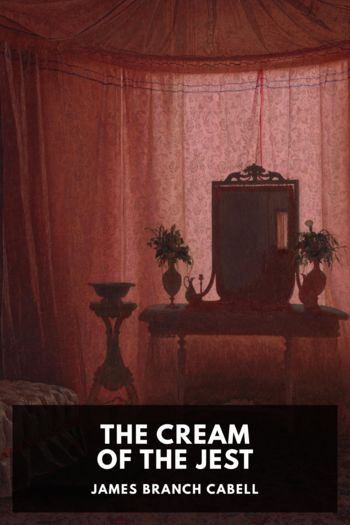The Cream of the Jest James Branch Cabell (recommended ebook reader TXT) 📖

- Author: James Branch Cabell
Book online «The Cream of the Jest James Branch Cabell (recommended ebook reader TXT) 📖». Author James Branch Cabell
There were before this, however, for Kennaston many glad hours of dabbling with proof-sheets: the tale seemed so different, and so infernally good, in print. Kennaston never in his life found any other playthings comparable to those first wide-margined “galley proofs” of The Audit at Storisende. Here was the word, vexatiously repeated within three lines, which must be replaced by a synonym; and the clause which, when transposed, made the whole sentence gain in force and comeliness; and the curt sentence whose addition gave clarity to the paragraph, much as a pinch of alum clears turbid water; and the vaguely unsatisfactory adjective, for which a jet of inspiration suggested a substitute, of vastly different meaning, in the light of whose inevitable aptness you marveled over your preliminary obtuseness:—all these slight triumphs, one by one, first gladdened Kennaston’s labor and tickled his self-complacency. He could see no fault in the book.
His publishers had clearer eyes. His Preface, for one matter, they insisted on transposing to the rear of the volume, where it now figures as the book’s tolerably famous colophon—that curious exposition of Kennaston’s creed as artist. Then, for a title, The Audit at Storisende was editorially adjudged abominable: people would not know how to pronounce Storisende, and in consequence would hold back from discussing the romance or even asking for it at book-dealers. Men Who Loved Ettarre was Kennaston’s ensuing suggestion; but the Baxon-Muir Company showed no fixed confidence in their patrons’ ability to pronounce Ettarre, either. Would it not be possible, they inquired, to change the heroine’s name?—and Kennaston assented. Thus it was that in the end his book came to be called Men Who Loved Alison.
But to Kennaston her name stayed always Ettarre. …
The book was delivered to the world, which received the gift without excitement. The book was delivered to reviewers, who found in it a well-intentioned echo of Mr. Maurice Hewlett’s earlier medieval tales. And there for a month or some six weeks, the matter rested.
Then one propitious morning an indignant gentlewoman in Brooklyn wrote to The New York Sphere a letter which was duly printed in that journal’s widely circulated Sunday supplement, The Literary Masterpieces of This Week, to denounce the loathsome and depraved indecency of the nineteenth and twentieth chapters, in which—while treating of Sir Guiron’s imprisonment in the Sacred Grove of Caer Idryn, and the worship accorded there to the sigil of Scoteia—Kennaston had touched upon some of the perverse refinements of antique sexual relations. The following week brought forth a full page of letters. Two of these, as Kennaston afterward learned, were contributed by the “publicity man” of the Baxon-Muir Company, and all arraigned obscenities which Kennaston could neither remember or on rereading his book discover. Later in this journal, as in other newspapers, appeared still more denunciations. An up-to-the-minute bishop expostulated from the pulpit against the story’s vicious tendencies, demanding that it be suppressed. Thereafter it was no longer on sale in the large department-stores alone, but was equally procurable at all the bookstands in hotels and railway stations. Even the author’s acquaintances began to read it. And the Delaunays (then at the height of their vogue as exponents of the “new” dances) introduced “the Alison amble”; and from Tampa to Seattle, in certain syndicated cartoons of generally appealing idiocy, newspaper readers were privileged to see one hero of the series knock the other heels over head with a copy of Kennaston’s romance. And women wore the “Alison aigrette” for a whole season; and a new brand of cheap tobacco christened in her honor had presently made her name at least familiar in saloons. Men Who Loved Alison became, in fine, the novel of the hour. It was one of those rare miracles such as sometimes palm off a well-written book upon the vast public that reads for pastime.
And shortly afterward Mr. Booth Tarkington published another of his delightful romances: one forgets at this distance of time just which it was: but, like all the others, it was exquisitely done, and sold neck and neck with Men Who Loved Alison; so that for a while it looked almost as if the American reading public was coming to condone adroit and careful composition.
But presently the advertising columns of magazines and newspapers were heralding the year’s vernal output of enduring masterworks in the field of fiction: and readers were again assured that the great American novel had just been published at last, by any number of persons: and so, the autumnal predecessors of these new chefs d’œuvre passed swiftly into oblivion, via the brief respite of a “popular” edition. And naturally, Kennaston’s romance was forgotten, by all save a few pensive people. Some of them had found in this volume food for curious speculation.
That, however, is a matter to be taken up later.
XIII Suggesting Themes of Universal AppealSo Felix Kennaston saw his dream vulgarized, made a low byword; and he contemplated this travestying, as the cream of a sardonic jest, with urbanity. Indeed, that hour of notoriety seemed not without its pleasant features to Felix Kennaston, who had all a poet’s ordinary appetite for flattery. Besides, it was droll to





Comments (0)